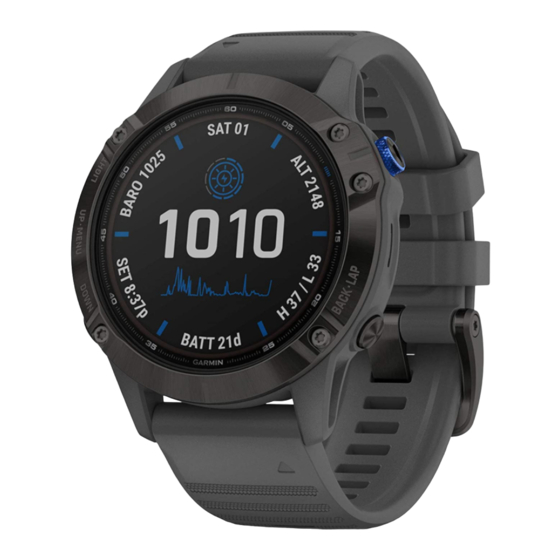Garmin Fenix 6 Gebruikershandleiding - Pagina 24
Blader online of download pdf Gebruikershandleiding voor {categorie_naam} Garmin Fenix 6. Garmin Fenix 6 26 pagina's. Turn on smart watch of 2022 - go wiki
Ook voor Garmin Fenix 6: Faq (5 pagina's), How-To (8 pagina's)

Recovery Heart Rate
If you are training with wrist-based heart rate or a compatible
chest heart rate monitor, you can check your recovery heart rate
value after each activity. Recovery heart rate is the difference
between your exercising heart rate and your heart rate two
minutes after the exercise has stopped. For example, after a
typical
training
run,
you stop the timer. Your heart rate is
140 bpm. After two minutes of no activity or cool down, your
heart rate is 90 bpm. Your recovery heart rate is 50 bpm (140
minus 90). Some studies have linked recovery heart rate to
cardiac health. Higher numbers generally indicate healthier
hearts.
TIP: For best
results,
you should stop moving for two minutes
while the device calculates your recovery heart rate value. You
can save or discard the activity after this value appears.
,..
Body Battery
Your device analyzes your heart rate variability, stress level,
sleep quality, and activity data to determine your overall Body
Battery level. Like a gas gauge on a car, it indicates your
amount of available reserve energy. The Body Battery
range is from Oto 100, where Oto 25 is low reserve energy, 26
to 50 is medium reserve energy, 51 to 75 is high reserve energy,
and 76 to 100 is very high reserve energy.
You can sync your device with your Garmin Connect account to
view your most up-to-date Body Battery level, long-term
and additional details
(Tips tor Improved Body Battery Data,
page
18).
Viewing the Body Battery Widget
The Body Battery widget displays your current Body Battery
level
and a graph of your Body Battery
hours.
1 Press UP or DOWN to view the Body Battery widget.
NOTE: You may need to add the widget to your widget loop
(Customizing the Widget Loop, page
2 Press @ to view a graph of your body battery level for the last
four hours.
3 Press DOWN to view a combined graph of your Body Battery
and stress levels.
Blue bars indicate periods of rest. Orange bars indicate
periods of stress. Gray bars indicate times when you were
too active to determine your stress level.
4
Press DOWN to see your Body Battery data since midnight.
Tips for Improved Body Battery Data
• Your Body Battery level updates when you sync your device
with your Garmin Connect account.
• For more accurate results, wear the device while
• Rest and good sleep charge your Body Battery.
• Strenuous activity, high stress, and poor sleep can cause
your Body Battery to drain.
• Food intake, as well as stimulants like caffeine, has no
impact on your Body Battery.
Pulse Oximeter
The fenix device has a wrist-based pulse oximeter to gauge the
peripheral saturation of oxygen in your blood. Knowing your
oxygen saturation can help you determine how your body is
acclimating to high altitudes for alpine sport and expedition.
You can manually begin a pulse oximeter reading by viewing the
pulse oximeter widget
(
Getting Pulse Oximeter Readings,
page
18). You can also tum on all-day readings
All-Day Pulse Oximeter Readings, page
motionless, your device analyzes your oxygen saturation and
your elevation. The elevation profile helps indicate how your
18
level
trends,
level
for the last several
30).
sleeping.
(Turning On
18). When you remain
pulse oximeter readings are changing, relative to your to
elevation.
On the
device,
your pulse oximeter reading appears as an
oxygen saturation percentage and color on the graph. On your
Garmin Connect account, you can view
your pulse oximeter
readings,
days.
For more information about pulse oximeter accuracy, go to
garmin.com/ataccuracy.
©
The oxygen saturation percentage scale.
A graph of your average oxygen saturation readings for the last 24
@
hours.
Your most recent oxygen saturation reading.
@
©
The elevation scale.
®
A graph of your elevation readings for the last 24 hours.
Getting Pulse Oximeter Readings
You can manually begin a pulse oximeter reading by viewing the
pulse oximeter widget. The widget displays your most recent
blood oxygen saturation percentage, a graph of your hourly
average readings for the last 24 hours, and a graph of your
elevation for the last 24 hours.
NOTE: The first time you view the pulse oximeter
device must acquire satellite signals to determine your elevation.
You should go
outside,
and wait while the device locates
satellites.
1 While you are sitting or
inactive,
the pulse oximeter widget.
2
Press@ to view widget details and begin a pulse oximeter
reading.
3
Remain motionless for up to 30 seconds.
NOTE: If you are too active for the watch to get a pulse
oximeter
reading,
a message appears instead of a
percentage. You can check again after
inactivity.
For
best results, hold the arm wearing the device at
heart level while the device reads your blood oxygen
saturation.
4
Press DOWN to view a graph of your pulse oximeter
readings for the last seven days.
Turning On All-Day Pulse Oximeter Readings
1
From the pulse oximeter widget, hold MENU.
2
Select Options > Pulse Ox Mode > All Day.
The device automatically analyzes your oxygen saturation
throughout the day, when you are not moving.
NOTE: Turning on all-day acclimation mode decreases
battery
life.
Turning Off Automatic Pulse Oximeter
Readings
1
From the pulse oximeter
widget,
2
Select Options > Pulse Ox Mode > Off.
additional
details about
including trends over multiple
widget,
the
press UP or DOWN to
view
several
minutes of
hold MENU.
Pulse Oximeter
